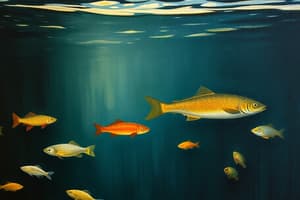Podcast
Questions and Answers
What is one of the implications of energy flow within an ecosystem regarding trophic levels?
What is one of the implications of energy flow within an ecosystem regarding trophic levels?
- Only one trophic level can exist in an ecosystem.
- Multiple trophic levels do not affect energy distribution.
- Ecosystems can have unlimited trophic levels.
- The number of trophic levels is limited due to energy constraints. (correct)
Why is it generally considered more efficient to consume plants rather than animals?
Why is it generally considered more efficient to consume plants rather than animals?
- Plants represent a higher trophic level than animals.
- Plants have a higher nutrient density than animals.
- Plants convert energy directly from the sun, making them more efficient. (correct)
- Eating plants does not require energy conversion.
In the carbon cycle, what role do plants play?
In the carbon cycle, what role do plants play?
- They consume CO2 from the soil.
- They release CO2 back into the atmosphere through respiration.
- They act as primary consumers in the food chain.
- They remove CO2 from the atmosphere during photosynthesis. (correct)
What are biogeochemical cycles primarily characterized by?
What are biogeochemical cycles primarily characterized by?
How do humans impact the carbon cycle?
How do humans impact the carbon cycle?
What percentage of the energy from primary consumers is typically available for secondary consumers?
What percentage of the energy from primary consumers is typically available for secondary consumers?
Which statement accurately describes an organism's position in a food web?
Which statement accurately describes an organism's position in a food web?
How much energy is converted by plants from sunlight for the next trophic level?
How much energy is converted by plants from sunlight for the next trophic level?
In the provided model of the energy budget, how many kilocalories of sunlight are required to produce 1,000 kcal of producer biomass?
In the provided model of the energy budget, how many kilocalories of sunlight are required to produce 1,000 kcal of producer biomass?
What amount of energy is typically passed as indigestible material, often referred to as 'frass', at each trophic level?
What amount of energy is typically passed as indigestible material, often referred to as 'frass', at each trophic level?
What is the approximate total energy available to tertiary consumers based on the provided model?
What is the approximate total energy available to tertiary consumers based on the provided model?
What is the expected energy loss when moving from producers to primary consumers?
What is the expected energy loss when moving from producers to primary consumers?
Which trophic level typically contains the least amount of energy based on the energy budget model?
Which trophic level typically contains the least amount of energy based on the energy budget model?
Flashcards are hidden until you start studying
Study Notes
Trophic Structure of a Community
- Food chains represent the flow of energy through an ecosystem.
- Food webs illustrate an organism's potential position in multiple trophic levels.
- For example, a mouse is a primary consumer (eating plants) and a secondary consumer (eating grasshoppers).
Energy Budgets of Trophic Levels
- Only a small portion of solar energy is captured by producers (plants).
- Approximately 1% of solar energy is converted into energy for the next trophic level.
- Energy transfer between trophic levels is inefficient, with only 10% transferred to the next level.
Implications of Energy Transfers
- Limited number of trophic levels in an ecosystem due to energy loss with each transfer.
- Eating plants is more efficient than eating animals because less energy is lost through the food chain.
Carbon Cycling
- Carbon is the fundamental element of life.
- Major carbon reservoirs include the atmosphere, rocks, and oceans.
- Plants remove CO2 from the atmosphere through photosynthesis.
- Carbon moves through the food chain via consumption.
- CO2 is returned to the atmosphere through respiration, decomposition, and burning of fossil fuels.
- Human activities significantly impact the carbon cycle.
Studying That Suits You
Use AI to generate personalized quizzes and flashcards to suit your learning preferences.




